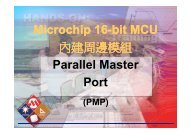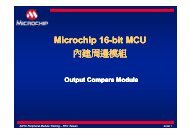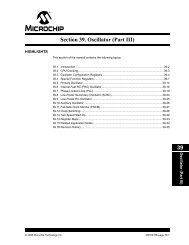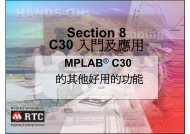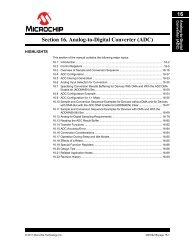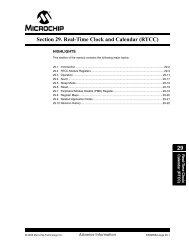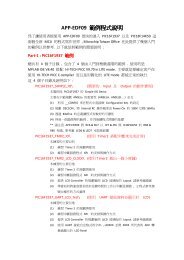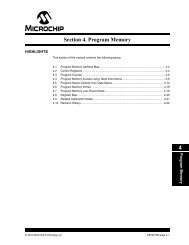PIC32MX Section 8 Interrupts Complete Reference Manual
PIC32MX Section 8 Interrupts Complete Reference Manual
PIC32MX Section 8 Interrupts Complete Reference Manual
You also want an ePaper? Increase the reach of your titles
YUMPU automatically turns print PDFs into web optimized ePapers that Google loves.
<strong>Section</strong> 8. <strong>Interrupts</strong>HIGHLIGHTSThis section of the manual contains the following topics:8.1 Introduction ................................................................................................................... 8-28.2 Control Registers .......................................................................................................... 8-38.3 Operation ....................................................................................................................8-128.4 Single Vector Mode..................................................................................................... 8-148.5 Multi-Vector Mode ....................................................................................................... 8-158.6 Interrupt Vector Address Calculation........................................................................... 8-168.7 Interrupt Priorities........................................................................................................8-178.8 <strong>Interrupts</strong> and Register Sets ....................................................................................... 8-188.9 Interrupt Processing.................................................................................................... 8-198.10 External <strong>Interrupts</strong>....................................................................................................... 8-238.11 Temporal Proximity Interrupt Coalescing .................................................................... 8-248.12 Effects of <strong>Interrupts</strong> After Reset .................................................................................. 8-258.13 Operation in Power-Saving and Debug Modes........................................................... 8-258.14 Design Tips .................................................................................................................8-268.15 Related Application Notes........................................................................................... 8-278.16 Revision History .......................................................................................................... 8-288<strong>Interrupts</strong>© 2009 Microchip Technology Inc. DS61108E-page 8-1
<strong>PIC32MX</strong> Family <strong>Reference</strong> <strong>Manual</strong>8.1 INTRODUCTIONThe <strong>PIC32MX</strong> generates interrupt requests in response to interrupt events from peripheral modules.The Interrupt module exists external to the CPU logic and prioritizes the interrupt eventsbefore presenting them to the CPU.The <strong>PIC32MX</strong> <strong>Interrupts</strong> module includes the following features:• Up to 96 interrupt sources• Up to 64 interrupt vectors• Single and Multi-Vector mode operations• Five external interrupts with edge polarity control• Interrupt proximity timer• Module freeze in Debug mode• Seven user-selectable priority levels for each vector• Four user-selectable subpriority levels within each priority• User-configurable shadow set based on priority level (this feature is not available on alldevices; refer to the specific device data sheet for availability)• Software can generate any interrupt• User-configurable interrupt vector table location• User-configurable interrupt vector spacingFigure 8-1:Interrupt Controller ModuleInterrupt RequestsInterrupt ControllerVector NumberPriority LevelCPU CoreShadow Set NumberNote:Several of the registers cited in this section are not in the interrupt controller module.These registers (and bits) are associated with the CPU. Refer to <strong>Section</strong> 2. “MCU”(DS61113) for more details.To avoid confusion, a typographic distinction is made for registers in the CPU. Theregister names in this section, and all other sections of this manual, are signified byuppercase letters only (except for cases in which variables are used). CPU registernames are signified by upper and lowercase letters. For example, INTSTAT is an<strong>Interrupts</strong> register; whereas, IntCtl is a CPU register.DS61108E-page 8-2© 2009 Microchip Technology Inc.
<strong>Section</strong> 8. <strong>Interrupts</strong>8.2 CONTROL REGISTERSNote:Each <strong>PIC32MX</strong> device variant may have one or more Interrupt sources, and depending on thedevice variant, the number of sources may be different. An ‘x’ used in the names ofcontrol/status bits and registers denotes that there are multiple registers, which have the samefunction, that can define these interrupt sources. Refer to the specific device data sheet formore details.The <strong>Interrupts</strong> module consists of the following Special Function Registers (SFRs):• INTCON: Interrupt Control Register• INTSTAT: Interrupt Status Register• TPTMR: Temporal Proximity Timer Register• IFSx: Interrupt Flag Status Registers• IECx: Interrupt Enable Control Registers• IPCx: Interrupt Priority Control RegistersTable 8-1 provides a brief summary of the related <strong>Interrupts</strong> module registers. Correspondingregisters appear after the summary, followed by a detailed description of each register.Table 8-1:AddressOffsetName<strong>Interrupts</strong> Register SummaryBitRangeBit31/23/15/7Bit30/22/14/6Bit29/21/13/5Bit28/20/12/4Bit27/19/11/3Bit26/18/10/2Bit25/17/9/1Bit24/16/8/00x00 INTCON (1,2,3) 31:24 — — — — — — — —23:16 — — — — — — — SS015:8 — FRZ — MVEC — TPC7:0 — — — INT4EP INT3EP INT2EP INT1EP INT0EP0x10 INTSTAT (1,2,3) 31:24 — — — — — — — —23:16 — — — — — — — —15:8 — — — — — RIPL7:0 — — VEC0x20 TPTMR (1,2,3) 31:24 TPTMR23:16 TPTMR15:8 TPTMR7:0 TPTMR0x30- IFSx (1,2,3) 31:24 IFS31 IFS30 IFS29 IFS28 IFS27 IFS26 IFS25 IFS240x5023:16 IFS23 IFS22 IFS21 IFS20 IFS19 IFS18 IFS17 IFS1615:8 IFS15 IFS14 IFS13 IFS12 IFS11 IFS10 IFS09 IFS087:0 IFS07 IFS06 IFS05 IFS04 IFS03 IFS02 IFS01 IFS000x60- IECx (1,2,3) 31:24 IEC31 IEC30 IEC29 IEC28 IEC27 IEC26 IEC25 IEC240x8023:16 IEC23 IEC22 IEC21 IEC20 IEC19 IEC18 IEC17 IEC1615:8 IEC15 IEC14 IEC13 IEC12 IEC11 IEC10 IEC09 IEC087:0 IEC07 IEC06 IEC05 IEC04 IEC03 IEC02 IEC01 IEC000x90- IPCx (1,2,3) 31:24 — — — IP03 IS030x18023:16 — — — IP02 IS0215:8 — — — IP01 IS017:0 — — — IP00 IS00Legend: — = unimplemented, read as ‘0’. Address offset values are shown in hexadecimal.Note 1: This register has an associated Clear register at an offset of 0x4 bytes. These registers have the same name with CLR appended to theend of the register name (e.g., INTCONCLR). Writing a ‘1’ to any bit position in the Clear register will clear valid bits in the associatedregister. Reads from the Clear register should be ignored.2: This register has an associated Set register at an offset of 0x8 bytes. These registers have the same name with SET appended to theend of the register name (e.g., INTCONSET). Writing a ‘1’ to any bit position in the Set register will set valid bits in the associated register.Reads from the Set register should be ignored.3: This register has an associated Invert register at an offset of 0xC bytes. These registers have the same name with INV appended to theend of the register name (e.g., INTCONINV). Writing a ‘1’ to any bit position in the Invert register will invert valid bits in the associatedregister. Reads from the Invert register should be ignored.8<strong>Interrupts</strong>© 2009 Microchip Technology Inc. DS61108E-page 8-3
<strong>PIC32MX</strong> Family <strong>Reference</strong> <strong>Manual</strong>Register 8-1: INTCON: Interrupt Control Register (1,2,3)r-x r-x r-x r-x r-x r-x r-x r-x— — — — — — — —bit 31 bit 24r-x r-x r-x r-x r-x r-x r-x R/W-0— — — — — — — SS0bit 23 bit 16r-x R/W-0 r-x R/W-0 r-x R/W-0 R/W-0 R/W-0— FRZ — MVEC — TPCbit 15 bit 8r-x r-x r-x R/W-0 R/W-0 R/W-0 R/W-0 R/W-0— — — INT4EP INT3EP INT2EP INT1EP INT0EPbit 7 bit 0Legend:R = Readable bit W = Writable bit P = Programmable bit r = Reserved bitU = Unimplemented bit -n = Bit Value at POR: (‘0’, ‘1’, x = Unknown)bit 31-17bit 16bit 15bit 14bit 13bit 12bit 11Reserved: Write ‘0’; ignore readSS0: Single Vector Shadow Register Set bit1 = Single vector is presented with a shadow register set0 = Single vector is not presented with a shadow register setReserved: Write ‘0’; ignore readFRZ: Freeze in Debug Exception Mode bit1 = Freeze operation when CPU is in Debug Exception mode0 = Continue operation even when CPU is in Debug Exception modeNote: FRZ is writable in Debug Exception mode only, it is forced to ‘0’ in normal mode.Reserved: Write ‘0’; ignore readMVEC: Multi Vector Configuration bit1 = Interrupt controller configured for multi vectored mode0 = Interrupt controller configured for single vectored modeReserved: Write ‘0’; ignore readNote 1: This register has an associated Clear register (INTCONCLR) at an offset of 0x4 bytes. Writing a ‘1’ to anybit position in the Clear register will clear valid bits in the associated register. Reads from the Clear registershould be ignored.2: This register has an associated Set register (INTCONSET) at an offset of 0x8 bytes. Writing a ‘1’ to anybit position in the Set register will set valid bits in the associated register. Reads from the Set registershould be ignored.3: This register has an associated Invert register (INTCONINV) at an offset of 0xC bytes. Writing a ‘1’ to anybit position in the Invert register will invert valid bits in the associated register. Reads from the Invertregister should be ignored.DS61108E-page 8-4© 2009 Microchip Technology Inc.
<strong>Section</strong> 8. <strong>Interrupts</strong>Register 8-1:bit 10-8bit 7-5bit 4bit 3bit 2bit 1bit 0INTCON: Interrupt Control Register (1,2,3) (Continued)TPC: Temporal Proximity Control bits111 = <strong>Interrupts</strong> of group priority 7 or lower start the TP timer110 = <strong>Interrupts</strong> of group priority 6 or lower start the TP timer101 = <strong>Interrupts</strong> of group priority 5 or lower start the TP timer100 = <strong>Interrupts</strong> of group priority 4 or lower start the TP timer011 = <strong>Interrupts</strong> of group priority 3 or lower start the TP timer010 = <strong>Interrupts</strong> of group priority 2 or lower start the TP timer001 = <strong>Interrupts</strong> of group priority 1 start the IP timer000 = Disables proximity timerReserved: Write ‘0’; ignore readINT4EP: External Interrupt 4 Edge Polarity Control bit1 = Rising edge0 = Falling edgeINT3EP: External Interrupt 3 Edge Polarity Control bit1 = Rising edge0 = Falling edgeINT2EP: External Interrupt 2 Edge Polarity Control bit1 = Rising edge0 = Falling edgeINT1EP: External Interrupt 1 Edge Polarity Control bit1 = Rising edge0 = Falling edgeINT0EP: External Interrupt 0 Edge Polarity Control bit1 = Rising edge0 = Falling edgeNote 1: This register has an associated Clear register (INTCONCLR) at an offset of 0x4 bytes. Writing a ‘1’ to anybit position in the Clear register will clear valid bits in the associated register. Reads from the Clear registershould be ignored.2: This register has an associated Set register (INTCONSET) at an offset of 0x8 bytes. Writing a ‘1’ to anybit position in the Set register will set valid bits in the associated register. Reads from the Set registershould be ignored.3: This register has an associated Invert register (INTCONINV) at an offset of 0xC bytes. Writing a ‘1’ to anybit position in the Invert register will invert valid bits in the associated register. Reads from the Invertregister should be ignored.8<strong>Interrupts</strong>© 2009 Microchip Technology Inc. DS61108E-page 8-5
<strong>PIC32MX</strong> Family <strong>Reference</strong> <strong>Manual</strong>Register 8-2: INTSTAT: Interrupt Status Register (1,2,3)r-x r-x r-x r-x r-x r-x r-x r-x— — — — — — — —bit 31 bit 24r-x r-x r-x r-x r-x r-x r-x r-x— — — — — — — —bit 23 bit 16r-x r-x r-x r-x r-x R-0 R-0 R-0— — — — — RIPLbit 15 bit 8r-x r-x R-0 R-0 R-0 R-0 R-0 R-0— — VECbit 7 bit 0Legend:R = Readable bit W = Writable bit P = Programmable bit r = Reserved bitU = Unimplemented bit -n = Bit Value at POR: (‘0’, ‘1’, x = Unknown)bit 31-11bit 10-8bit 7-6bit 5-0Reserved: Write ‘0’; ignore readRIPL: Requested Priority Level bits000-111 = The priority level of the latest interrupt presented to the CPUNote:This value should only be used when the interrupt controller is configured for SingleVector mode.Reserved: Write ‘0’; ignore readVEC: Interrupt Vector bits00000-11111 = The interrupt vector that is presented to the CPUNote:This value should only be used when the interrupt controller is configured for SingleVector mode.Note 1: This register has an associated Clear register (INTSTATCLR) at an offset of 0x4 bytes. Writing a ‘1’ to anybit position in the Clear register will clear valid bits in the associated register. Reads from the Clear registershould be ignored.2: This register has an associated Set register (INTSTATSET) at an offset of 0x8 bytes. Writing a ‘1’ to anybit position in the Set register will set valid bits in the associated register. Reads from the Set registershould be ignored.3: This register has an associated Invert register (INTSTATINV) at an offset of 0xC bytes. Writing a ‘1’ to anybit position in the Invert register will invert valid bits in the associated register. Reads from the Invertregister should be ignored.DS61108E-page 8-6© 2009 Microchip Technology Inc.
<strong>Section</strong> 8. <strong>Interrupts</strong>Register 8-3: TPTMR: Temporal Proximity Timer Register (1,2,3)R/W-0 R/W-0 R/W-0 R/W-0 R/W-0 R/W-0 R/W-0 R/W-0TPTMRbit 31 bit 24R/W-0 R/W-0 R/W-0 R/W-0 R/W-0 R/W-0 R/W-0 R/W-0TPTMRbit 23 bit 16R/W-0 R/W-0 R/W-0 R/W-0 R/W-0 R/W-0 R/W-0 R/W-0TPTMRbit 15 bit 8R/W-0 R/W-0 R/W-0 R/W-0 R/W-0 R/W-0 R/W-0 R/W-0TPTMRbit 7 bit 0Legend:R = Readable bit W = Writable bit P = Programmable bit r = Reserved bitU = Unimplemented bit -n = Bit Value at POR: (‘0’, ‘1’, x = Unknown)8bit 31-0TPTMR: Temporal Proximity Timer Reload bitsUsed by the Temporal Proximity Timer as a reload value when the Temporal Proximity timer istriggered by an interrupt event.Note 1: This register has an associated Clear register (TPTMRCLR) at an offset of 0x4 bytes. Writing a ‘1’ to anybit position in the Clear register will clear valid bits in the associated register. Reads from the Clear registershould be ignored.2: This register has an associated Set register (TPTMRSET) at an offset of 0x8 bytes. Writing a ‘1’ to any bitposition in the Set register will set valid bits in the associated register. Reads from the Set register shouldbe ignored.3: This register has an associated Invert register (TPTMRINV) at an offset of 0xC bytes. Writing a ‘1’ to anybit position in the Invert register will invert valid bits in the associated register. Reads from the Invertregister should be ignored.<strong>Interrupts</strong>© 2009 Microchip Technology Inc. DS61108E-page 8-7
<strong>PIC32MX</strong> Family <strong>Reference</strong> <strong>Manual</strong>Register 8-4: IFSx: Interrupt Flag Status Register (1,2,3,4)R/W-0 R/W-0 R/W-0 R/W-0 R/W-0 R/W-0 R/W-0 R/W-0IFS31 IFS30 IFS29 IFS28 IFS27 IFS26 IFS25 IFS24bit 31 bit 24R/W-0 R/W-0 R/W-0 R/W-0 R/W-0 R/W-0 R/W-0 R/W-0IFS23 IFS22 IFS21 IFS20 IFS19 IFS18 IFS17 IFS16bit 23 bit 16R/W-0 R/W-0 R/W-0 R/W-0 R/W-0 R/W-0 R/W-0 R/W-0IFS15 IFS14 IFS13 IFS12 IFS11 IFS10 IFS09 IFS08bit 15 bit 8R/W-0 R/W-0 R/W-0 R/W-0 R/W-0 R/W-0 R/W-0 R/W-0IFS07 IFS06 IFS05 IFS04 IFS03 IFS02 IFS01 IFS00bit 7 bit 0Legend:R = Readable bit W = Writable bit P = Programmable bit r = Reserved bitU = Unimplemented bit -n = Bit Value at POR: (‘0’, ‘1’, x = Unknown)bit 31-0IFS31-IFS00: Interrupt Flag Status bits1 = Interrupt request has occurred0 = No interrupt request has occurredNote 1: This register represents a generic definition of the IFSx register. Refer to the “<strong>Interrupts</strong>” chapter in thespecific device data sheet to learn exact bit definitions.2: These registers have an associated Clear register (IFSxCLR) at an offset of 0x4 bytes. Writing a ‘1’ to anybit position in the Clear register will clear valid bits in the associated register. Reads from the Clear registershould be ignored.3: These registers have an associated Set register (IFSxSET) at an offset of 0x8 bytes. Writing a ‘1’ to anybit position in the Set register will set valid bits in the associated register. Reads from the Set registershould be ignored.4: These registers have an associated Invert register (IFSxINV) at an offset of 0xC bytes. Writing a ‘1’ to anybit position in the Invert register will invert valid bits in the associated register. Reads from the Invertregister should be ignored.DS61108E-page 8-8© 2009 Microchip Technology Inc.
<strong>Section</strong> 8. <strong>Interrupts</strong>Register 8-5: IECx: Interrupt Enable Control Register (1,2,3,4)R/W-0 R/W-0 R/W-0 R/W-0 R/W-0 R/W-0 R/W-0 R/W-0IEC31 IEC30 IEC29 IEC28 IEC27 IEC26 IEC25 IEC24bit 31 bit 24R/W-0 R/W-0 R/W-0 R/W-0 R/W-0 R/W-0 R/W-0 R/W-0IEC23 IEC22 IEC21 IEC20 IEC19 IEC18 IEC17 IEC16bit 23 bit 16R/W-0 R/W-0 R/W-0 R/W-0 R/W-0 R/W-0 R/W-0 R/W-0IEC15 IEC14 IEC13 IEC12 IEC11 IEC10 IEC09 IEC08bit 15 bit 8R/W-0 R/W-0 R/W-0 R/W-0 R/W-0 R/W-0 R/W-0 R/W-0IEC07 IEC06 IEC05 IEC04 IEC03 IEC02 IEC01 IEC00bit 7 bit 0Legend:R = Readable bit W = Writable bit P = Programmable bit r = Reserved bitU = Unimplemented bit -n = Bit Value at POR: (‘0’, ‘1’, x = Unknown)8bit 31-0IEC31-IEC00: Interrupt Enable bits1 = Interrupt is enabled0 = Interrupt is disabledNote 1: This register represents a generic definition of the IECx register. Refer to the “<strong>Interrupts</strong>” chapter in thespecific device data sheet to learn exact bit definitions.2: These registers have an associated Clear register (IECxCLR) at an offset of 0x4 bytes. Writing a ‘1’ to anybit position in the Clear register will clear valid bits in the associated register. Reads from the Clear registershould be ignored.3: These registers have an associated Set register (IECxSET) at an offset of 0x8 bytes. Writing a ‘1’ to anybit position in the Set register will set valid bits in the associated register. Reads from the Set registershould be ignored.4: These registers have an associated Invert register (IECxINV) at an offset of 0xC bytes. Writing a ‘1’ to anybit position in the Invert register will invert valid bits in the associated register. Reads from the Invertregister should be ignored.<strong>Interrupts</strong>© 2009 Microchip Technology Inc. DS61108E-page 8-9
<strong>PIC32MX</strong> Family <strong>Reference</strong> <strong>Manual</strong>Register 8-6: IPCx: Interrupt Priority Control Register (1,2,3,4)r-x r-x r-x R/W-0 R/W-0 R/W-0 R/W-0 R/W-0— — — IP03 IS03bit 31 bit 24r-x r-x r-x R/W-0 R/W-0 R/W-0 R/W-0 R/W-0— — — IP02 IS02bit 23 bit 16r-x r-x r-x R/W-0 R/W-0 R/W-0 R/W-0 R/W-0— — — IP01 IS01bit 15 bit 8r-x r-x r-x R/W-0 R/W-0 R/W-0 R/W-0 R/W-0— — — IP00 IS00bit 7 bit 0Legend:R = Readable bit W = Writable bit P = Programmable bit r = Reserved bitU = Unimplemented bit -n = Bit Value at POR: (‘0’, ‘1’, x = Unknown)bit 31-29bit 28-26bit 25-24bit 23-21Reserved: Write ‘0’; ignore readIP03: Interrupt Priority bits111 = Interrupt priority is 7110 = Interrupt priority is 6101 = Interrupt priority is 5100 = Interrupt priority is 4011 = Interrupt priority is 3010 = Interrupt priority is 2001 = Interrupt priority is 1000 = Interrupt is disabledIS03: Interrupt Subpriority bits11 = Interrupt subpriority is 310 = Interrupt subpriority is 201 = Interrupt subpriority is 100 = Interrupt subpiority is 0Reserved: Write ‘0’; ignore readNote 1: This register represents a generic definition of the IPCx register. Refer to the “<strong>Interrupts</strong>” chapter in thespecific device data sheet to learn exact bit definitions.2: These registers have an associated Clear register (IPCxCLR) at an offset of 0x4 bytes. Writing a ‘1’ to anybit position in the Clear register will clear valid bits in the associated register. Reads from the Clear registershould be ignored.3: These registers have an associated Set register (IPCxSET) at an offset of 0x8 bytes. Writing a ‘1’ to anybit position in the Set register will set valid bits in the associated register. Reads from the Set registershould be ignored.4: These registers have an associated Invert register (IPCxINV) at an offset of 0xC bytes. Writing a ‘1’ to anybit position in the Invert register will invert valid bits in the associated register. Reads from the Invertregister should be ignored.DS61108E-page 8-10© 2009 Microchip Technology Inc.
<strong>Section</strong> 8. <strong>Interrupts</strong>Register 8-6:bit 20-18bit 17-16bit 15-13bit 12-10bit 9-8bit 7-5bit 4-2bit 1-0IPCx: Interrupt Priority Control Register (1,2,3,4) (Continued)IP02: Interrupt Priority bits111 = Interrupt priority is 7110 = Interrupt priority is 6101 = Interrupt priority is 5100 = Interrupt priority is 4011 = Interrupt priority is 3010 = Interrupt priority is 2001 = Interrupt priority is 1000 = Interrupt is disabledIS02: Interrupt Subpriority bits11 = Interrupt subpriority is 310 = Interrupt subpriority is 201 = Interrupt subpriority is 100 = Interrupt subpriority is 0Reserved: Write ‘0’; ignore readIP01: Interrupt Priority bits111 = Interrupt priority is 7110 = Interrupt priority is 6101 = Interrupt priority is 5100 = Interrupt priority is 4011 = Interrupt priority is 3010 = Interrupt priority is 2001 = Interrupt priority is 1000 = Interrupt is disabledIS01: Interrupt Subpriority bits11 = Interrupt subpriority is 310 = Interrupt subpriority is 201 = Interrupt subpriority is 100 = Interrupt subpriority is 0Reserved: Write ‘0’; ignore readIP00: Interrupt Priority bits111 = Interrupt priority is 7110 = Interrupt priority is 6101 = Interrupt priority is 5100 = Interrupt priority is 4011 = Interrupt priority is 3010 = Interrupt priority is 2001 = Interrupt priority is 1000 = Interrupt is disabledIS00: Interrupt Subpriority bits11 = Interrupt subpriority is 310 = Interrupt subpriority is 201 = Interrupt subpriority is 100 = Interrupt subpriority is 08<strong>Interrupts</strong>Note 1: This register represents a generic definition of the IPCx register. Refer to the “<strong>Interrupts</strong>” chapter in thespecific device data sheet to learn exact bit definitions.2: These registers have an associated Clear register (IPCxCLR) at an offset of 0x4 bytes. Writing a ‘1’ to anybit position in the Clear register will clear valid bits in the associated register. Reads from the Clear registershould be ignored.3: These registers have an associated Set register (IPCxSET) at an offset of 0x8 bytes. Writing a ‘1’ to anybit position in the Set register will set valid bits in the associated register. Reads from the Set registershould be ignored.4: These registers have an associated Invert register (IPCxINV) at an offset of 0xC bytes. Writing a ‘1’ to anybit position in the Invert register will invert valid bits in the associated register. Reads from the Invertregister should be ignored.© 2009 Microchip Technology Inc. DS61108E-page 8-11
<strong>PIC32MX</strong> Family <strong>Reference</strong> <strong>Manual</strong>8.3 OPERATIONThe interrupt controller is responsible for pre-processing interrupt requests (IRQs) from a numberof on-chip peripherals and presenting them in the appropriate order to the processor.Figure 8-2 depicts the interrupt process within the <strong>PIC32MX</strong>. The interrupt controller is designedto receive up to 96 IRQs from the processor core, on-chip peripherals capable of generatinginterrupts, and five external inputs. All IRQs are sampled on the rising edge of the SYSCLK andlatched in associated IFSx registers. A pending IRQ is indicated by the flag bit being equal to ‘1’in an IFSx register. The pending IRQ will not cause further processing if the corresponding bit inthe interrupt enable (IECx) register is clear. The IECx bits act to gate the interrupt flag. If the interruptis enabled, all IRQs are encoded into a 5-bit-wide vector number. The 5-bit vector results in0 to 63 unique interrupt vector numbers. Since there are more IRQs than available vector numbers,some IRQs share common vector numbers. Each vector number is assigned aninterrupt-priority-level and shadow-set number. The priority level is determined by the IPCx registersetting of associated vector. In Multi-Vector mode, the user can select a priority level toreceive a dedicated shadow register set. In Single Vector mode, all interrupts may receive a dedicatedshadow set. The interrupt controller selects the highest priority IRQ among all pendingIRQs and presents the associated vector number, priority-level and shadow-set number to theprocessor core.The processor core samples the presented vector information between the ‘E’ and ‘M’ stages ofthe pipeline. If the vector’s priority level presented to the core is greater than the current priorityindicated by the CPU Interrupt Priority bits IPL (Status), the interrupt is serviced; otherwise,it will remain pending until the current priority is less than the interrupt’s priority. When servicingan interrupt, the processor core pushes the program counter into the Exception ProgramCounter (EPC) register in the CPU and sets the Exception Level (EXL) bit (Status) in theCPU. The EXL bit disables further interrupts until the application explicitly re-enables them byclearing EXL bit. Next, it branches to the vector address calculated from the presented vectornumber.The INTSTAT register contains the Interrupt Vector Number (VEC) bits (INTSTAT) andRequested Interrupt Priority (RIPL) bits (INTSTAT) of the current pending interrupt. Thismay not be the same as the interrupt which caused the core to diverge from normal execution.The processor returns to the previous state when the ERET (Exception Return) instruction isexecuted. ERET clears the EXL bit, restores the program counter, and reverts the current shadowset to the previous one.The <strong>PIC32MX</strong> interrupt controller can be configured to operate in one of two modes:• Single Vector mode – all interrupt requests will be serviced at one vector address (modeout of reset).• Multi-Vector mode – interrupt requests will be serviced at the calculated vector address.Notes:While the user can, during run time, reconfigure the interrupt controller from SingleVector to Multi-Vector mode (or vice versa), such action is strongly discouraged.Changing interrupt controller modes after initialization may result inundefined behavior.The M4K core supports several different interrupt processing modes. The interruptcontroller is designed to work in External Interrupt Controller mode.DS61108E-page 8-12© 2009 Microchip Technology Inc.
<strong>Section</strong> 8. <strong>Interrupts</strong>Figure 8-2:Interrupt ProcessENCODE LATCH COMPARE GENERATEStatus IPLRIPL>IPLAny RequestInterrupt Request•Status IEInterrupt ExceptionInterrupt SourcesInterrupt ModuleVector NumberRequested IPLShadow Set NumberSRSCtl EICSS Cause RIPLLoadFieldsIntCtl VSOffsetGeneratorException Vector OffsetShadow Set Number8Note: SRSCtl, Cause, Status and IntCtl registers are CPU registers and are described in <strong>Section</strong> 2. “MCU” (DS61113).<strong>Interrupts</strong>© 2009 Microchip Technology Inc. DS61108E-page 8-13
<strong>PIC32MX</strong> Family <strong>Reference</strong> <strong>Manual</strong>8.4 SINGLE VECTOR MODEOn any form of reset, the interrupt controller initializes to Single Vector mode. When the MVEC(INTCON) bit is ‘0’, the interrupt controller operates in Single Vector mode. In this mode, theCPU always vectors to the same address.Note:Users familiar with MIPS32 architecture must note that the M4K core in the<strong>PIC32MX</strong> is still operating in External Interrupt Controller (EIC) mode. The<strong>PIC32MX</strong> achieves Single Vector mode by forcing all IRQs to use a vector numberof 0x00. Because the M4K core in the <strong>PIC32MX</strong> always operates in EIC mode, thesingle vector behavior through “Interrupt Compatibility Mode” as defined by MIPS32architecture is not recommended.To configure the CPU in <strong>PIC32MX</strong> Single Vector mode, the following CPU registers (IntCtl,Cause and Status) and INTCON register must be configured as follows:• EBase ≠ 00000• VS (IntCtl) ≠ 00000• IV (Cause) = 1• EXL (Status) = 0• BEV (Status) = 0• MVEC (INTCON) = 0• IE (Status) = 1Example 8-1: Single Vector Mode Initialization/*Set the CP0 registers for multi-vector interruptPlace EBASE at 0xBD000000*/This code example uses MPLAB C32 intrinsic functions to access CP0 registers.Check your compiler documentation to find equivalent functions or use inline assemblyunsigned int temp;asm volatile(“di”);temp = mips_getsr();temp |= 0x00400000;mips_setsr(temp);// Disable all interrupts// Get Status// Set BEV bit// Update Status_mips_mtc0(C0_EBASE, 0xBD000000); // Set an EBase value of 0xBD000000_mips_mtc0(C0_INTCTL, 0x00000020); // Set the Vector Spacing to non-zero valuetemp = mips_getcr();temp |= 0x00800000;mips_setcr(temp);temp = mips_getsr();temp &= 0xFFBFFFFD;mips_setsr(temp);INTCONCLR = 0x800;asm volatile(“ie”);// Get Cause// Set IV// Update Cause// Get Status// Clear BEV and EXL// Update Status// Clear MVEC bit// Enable all interruptsDS61108E-page 8-14© 2009 Microchip Technology Inc.
<strong>Section</strong> 8. <strong>Interrupts</strong>8.5 MULTI-VECTOR MODEWhen the MVEC (INTCON) bit is ‘1’, the interrupt controller operates in Multi-Vector mode.In this mode, the CPU vectors to the unique address for each vector number. Each vector islocated at a specific offset, with respect to a base address specified by the EBase (ExceptionBase) register in the CPU. The individual vector address offset is determined by the vector spacethat is specified by the VS bits in IntCtl register. (The IntCtl register is located in the CPU; referto <strong>Section</strong> 2. “MCU” (DS61113) for more details.)To configure the CPU in <strong>PIC32MX</strong> Multi-Vector mode, the following CPU registers (IntCtl, Causeand Status) and the INTCON register must be configured as follows:• EBase ≠ 00000• VS (IntCtl) ≠ 00000• IV (Cause) = 1• EXL (Status) = 0• BEV (Status) = 0• MVEC (INTCON) = 1• IE (Status) = 1Example 8-2:/**/Multi-Vector Mode InitializationSet the CP0 registers for multi-vector interruptPlace EBASE at 0xBD000000 and Vector Spacing to 32 bytesThis code example uses MPLAB C32 intrinsic functions to access CP0 registers.Check your compiler documentation to find equivalent functions or use inline assemblyunsigned int temp;asm volatile(“di”);temp = mips_getsr();temp |= 0x00400000;mips_setsr(temp);// Disable all interrupts// Get Status// Set BEV bit// Update Status8<strong>Interrupts</strong>_mips_mtc0(C0_EBASE, 0xBD000000); // Set an EBase value of 0xBD000000_mips_mtc0(C0_INTCTL, 0x00000020); // Set the Vector Spacing of 32 bytestemp = mips_getcr();// Get Causetemp |= 0x00800000;// Set IVmips_setcr(temp);// Update Causetemp = mips_getsr();temp &= 0xFFBFFFFD;mips_setsr(temp);INTCONSET = 0x800;asm volatile(“ie”);// Get Status// Clear BEV and EXL// Update Status// Set MVEC bit// Enable all interrupts© 2009 Microchip Technology Inc. DS61108E-page 8-15
<strong>PIC32MX</strong> Family <strong>Reference</strong> <strong>Manual</strong>8.6 INTERRUPT VECTOR ADDRESS CALCULATIONThe vector address for a particular interrupt depends on how the interrupt controller isconfigured. If the interrupt controller is configured for Single Vectored mode (see <strong>Section</strong> 8.4“Single Vector Mode”), all interrupt vectors use the same vector address. When it is configuredfor Multi-Vectored mode (see <strong>Section</strong> 8.5 “Multi-Vector Mode”), each interrupt vectorhas a unique vector address.On all forms of Reset, the processor enters in Bootstrap mode with Control bit BEV (Status)set. (The Status register is located in the CPU; refer to <strong>Section</strong> 2. “MCU” (DS61113) for moredetails.) While the processor is in Bootstrap mode, all interrupts are disabled and all generalexceptions are redirected to one interrupt vector address, 0xBFC00380. When configuring theinterrupt controller to the desired mode of operation, several registers must be set to specificvalues (see <strong>Section</strong> 8.4 “Single Vector Mode” and <strong>Section</strong> 8.5 “Multi-Vector Mode”) beforethe BEV bit is cleared.The vector address of a given interrupt is calculated using Exception Base (EBase)register, which provides a 4 KB page-aligned base address value located in the kernel segment(KSEG) address space. (EBase is a CPU register.)8.6.1 Multi-Vector Mode Address CalculationThe Multi-Vector mode address is calculated by using the EBase and VS (IntCtl) values.(The IntCtl and Status registers are located in the CPU.) The VS bits provide the spacing betweenadjacent vector addresses. Allowable vector spacing values are 32, 64, 128, 256 and 512 bytes.Modifications to EBase and VS values are only allowed when the BEV (Status) bit is ‘1’ inthe CPU. Example 8-3 shows how a multi-vector address is calculated for a given vector.Note:The Multi-Vector mode address calculation depends on the interrupt vector number.Each <strong>PIC32MX</strong> device family may have its own set of vector numbers depending onits feature set. See the respective device data sheet to find out vector numbersassociated with each interrupt source.Example 8-3: Vector Address for Vector Number 16vector address = vector number X (VS
<strong>Section</strong> 8. <strong>Interrupts</strong>8.7 INTERRUPT PRIORITIES8.7.1 Interrupt Group PriorityThe user is able to assign a group priority to each of the interrupt vectors. The groups’priority-level bits are located in the IPCx register. Each IPCx register contains group priority bitsfor four interrupt vectors. The user-selectable priority levels range from 1 (the lowest priority) to7 (the highest). If an interrupt priority is set to zero, the interrupt vector is disabled for both interruptand wake-up purposes. Interrupt vectors with a higher priority level preempt lower priorityinterrupts. The user must move the Requested Interrupt Priority (RIPL) bit of the Cause register(Cause) into the Status register’s Interrupt Priority (IPL) bits (Status) beforere-enabling interrupts. (The Cause and Status registers are located in the CPU; refer to <strong>Section</strong>2. “MCU” (DS61113) for more details.) This action will disable all lower priority interrupts until thecompletion of the Interrupt Service Routine (ISR).Note:The Interrupt Service Routine must clear the associated interrupt flag in the IFSxregister before lowering the interrupt priority level to avoid recursive interrupts.Example 8-4:Setting Group Priority Level/*The following code example will set the priority to level 2.Multi-Vector initialization must be performed (See Example 8-2)*/IPC0CLR = 0x0000001C; // clear the priority levelIPC0SET = 0x00000008; // set priority level to 288.7.2 Interrupt SubpriorityThe user can assign a subpriority level within each group priority. The subpriority will not causepreemption of an interrupt in the same priority; rather, if two interrupts with the same priority arepending, the interrupt with the highest subpriority will be handled first. The subpriority bits arelocated in the IPCx register. Each IPCx register contains subpriority bits for four of the interruptvectors. These bits define the subpriority within the priority level of the vector. Theuser-selectable subpriority levels range from 0 (the lowest subpriority) to 3 (the highest).<strong>Interrupts</strong>Example 8-5:Setting Subpriority Level/*The following code example will set the subpriority to level 2.Multi-Vector initialization must be performed (See Example 8-2)*/IPC0CLR = 0x00000003; // clear the subpriority levelIPC0SET = 0x00000002; // set the subpriority to 28.7.3 Interrupt Natural PriorityWhen multiple interrupts are assigned to same group priority and subpriority, they are prioritizedby their natural priority. The natural priority is a fixed priority scheme, where the highest naturalpriority starts at the lowest interrupt vector, meaning that interrupt vector 0 is the highest andinterrupt vector 63 is the lowest natural priority. See the interrupt vector table in the respectivedevice data sheet to learn the natural priority order of each IRQ.© 2009 Microchip Technology Inc. DS61108E-page 8-17
<strong>PIC32MX</strong> Family <strong>Reference</strong> <strong>Manual</strong>8.8 INTERRUPTS AND REGISTER SETSThe <strong>PIC32MX</strong> family of devices employs two register sets, a primary register set for normal programexecution and a shadow register set for highest priority interrupt processing. Register setselection is automatically performed by the interrupt controller. The exact method of register setselection varies by the interrupt controller modes of operation.In Single Vector and Multi-Vector modes of operation, the CSS field in the SRSCtl register providesthe current number of the register set in use, while the PSS field provides the number ofthe previous register set. (SRSCtl is a CPU register, refer to <strong>Section</strong> 2. “MCU” (DS61113) fordetails.) This information is useful to determine if the Stack and Global Data Pointers should becopied to the new register set, or not. If the current and previous register set are different, theinterrupt handler prologue may need to copy the Stack and Global Data Pointers from one set toanother. Most C compilers supporting the <strong>PIC32MX</strong> family of devices automatically generate thenecessary interrupt prologue code to handle this operation.8.8.1 Register Set Selection in Single Vector ModeIn Single Vector mode, the SS0 (INTCON) bit determines which register set will be used. Ifthe SS0 bit is ‘1’, the interrupt controller will instruct the CPU to use the second register set forall interrupts. If the SS0 bit is ‘0’, the interrupt controller will instruct the CPU to use the first registerset. Unlike Multi-Vector mode, there is no linkage between register set and interrupt priority.The application decides whether the second shadow set will be used at all.8.8.2 Register Set Selection in Multi-Vector ModeWhen a priority level interrupt matches a shadow set priority, the interrupt controller instructs theCPU to use the shadow set. For all other interrupt priorities, the interrupt controller instructs theCPU to use the primary register set. The interrupt priority that uses the shadow set will not needto perform any context save and restore. This results in increased code throughput anddecreases interrupt latency.DS61108E-page 8-18© 2009 Microchip Technology Inc.
<strong>Section</strong> 8. <strong>Interrupts</strong>8.9 INTERRUPT PROCESSINGWhen the priority of a requested interrupt is greater than the current CPU priority, the interruptrequest is taken and the CPU branches to the vector address associated with the requestedinterrupt. Depending on the priority of the interrupt, the prologue and epilogue of the interrupthandler must perform certain tasks before executing any useful code. The following examplesprovide recommended prologues and epilogues.8.9.1 Interrupt Processing in Single Vector ModeWhen the interrupt controller is configured in Single Vector mode, all of the interrupt requests areserviced at the same vector address. The interrupt handler routine must generate a prologue andan epilogue to properly configure, save and restore all of the core registers, along with GeneralPurpose Registers. At a worst case, all of the modifiable General Purpose Registers must besaved and restored by the prologue and epilogue.8.9.1.1 Single Vector Mode PrologueWhen entering the interrupt handler routine, the interrupt controller must first save the current priorityand exception PC counter from Interrupt Priority (IPL) bits (Status) and theErrorEPC register, respectively, on the stack. (Status and ErrorEPC are CPU registers.) If theroutine is presented a new register set, the previous register set’s stack register must be copiedto the current set’s stack register. Then the requested priority may be stored in the IPL from theRequested Interrupt Priority (RIPL) bits (Cause), Exception Level (EXL) bit and ErrorLevel (ERL) bit in the Status register (Status and Status) are cleared, and the MasterInterrupt Enable bit (Status) is set. Finally, the General Purpose Registers will be saved onthe stack. (The Cause and Status registers are located in the CPU.)8Example 8-6: Single Vector Interrupt Handler Prologue in Assembly Coderdpgpr sp, spmfc0 k0, Causemfc0 k1, EPCsrl k0, k0, 0xaaddiu sp, sp, -76sw k1, 0(sp)mfc0 k1, Statussw k1, 4(sp)ins k1, k0, 10, 6ins k1,zero, 1, 4mtc0 k1, Statussw s8, 8(sp)sw a0, 12(sp)sw a1, 16(sp)sw a2, 20(sp)sw a3, 24(sp)sw v0, 28(sp)sw v1, 32(sp)sw t0, 36(sp)sw t1, 40(sp)sw t2, 44(sp)sw t3, 48(sp)sw t4, 52(sp)sw t5, 56(sp)sw t6, 60(sp)sw t7, 64(sp)sw t8, 68(sp)sw t9, 72(sp)addu s8, sp, zero<strong>Interrupts</strong>// start interrupt handler code here© 2009 Microchip Technology Inc. DS61108E-page 8-19
<strong>PIC32MX</strong> Family <strong>Reference</strong> <strong>Manual</strong>8.9.1.2 Single Vector Mode EpilogueAfter completing all useful code of the interrupt handler routine, the original state of the Statusand EPC registers, along with the General Purpose Registers saved on the stack, must berestored.Example 8-7: Single Vector Interrupt Handler Epilogue in Assembly Code// end of interrupt handler codeaddulwlwlwlwlwlwlwlwlwlwlwlwlwlwlwlwlwdilwmtc0lwmtc0eretsp, s8, zerot9, 72(sp)t8, 68(sp)t7, 64(sp)t6, 60(sp)t5, 56(sp)t4, 52(sp)t3, 48(sp)t2, 44(sp)t1, 40(sp)t0, 36(sp)v1, 32(sp)v0, 28(sp)a3, 24(sp)a2, 20(sp)a1, 16(sp)a0, 12(sp)s8, 8(sp)k0, 0(sp)k0, EPCk0, 4(sp)k0, Status8.9.2 Interrupt Processing in Multi-Vector ModeWhen the interrupt controller is configured in Multi-Vector mode, the interrupt requests areserviced at the calculated vector addresses. The interrupt handler routine must generate aprologue and an epilogue to properly configure, save and restore all of the core registers, alongwith General Purpose Registers. At a worst case, all of the modifiable General Purpose Registersmust be saved and restored by the prologue and epilogue. If the interrupt priority is set to receiveit’s own General Purpose Register set, the prologue and epilogue will not need to save or restoreany of the modifiable General Purpose Registers, thus providing the lowest latency.8.9.2.1 Multi-Vector Mode PrologueWhen entering the interrupt handler routine, the Interrupt Service Routine must first save the currentpriority and exception PC counter from Interrupt Priority (IPL) bits (Status) and theErrorEPC register, respectively, on the stack. If the routine is presented a new register set, theprevious register set’s stack register must be copied to the current set’s stack register. Then therequested priority may be stored in the IPL from Requested Interrupt Priority (RIPL) bits(Cause), Exception Level (EXL) bit and Error Level (ERL) bit in the Status register(Status and Status) are cleared, and the Master Interrupt Enable bit (Status) is set. Ifthe interrupt handler is not presented a new General Purpose Register set, these resisters willbe saved on the stack. (Cause and Status are CPU registers; refer to <strong>Section</strong> 2. “MCU”(DS61113) for more details.)DS61108E-page 8-20© 2009 Microchip Technology Inc.
<strong>Section</strong> 8. <strong>Interrupts</strong>Example 8-8:Prologue Without a Dedicated General Purpose Register Set inAssembly Coderdpgpr sp, spmfc0 k0, Causemfc0 k1, EPCsrl k0, k0, 0xaaddiu sp, sp, -76sw k1, 0(sp)mfc0 k1, Statussw k1, 4(sp)ins k1, k0, 10, 6ins k1,zero, 1, 4mtc0 k1, Statussw s8, 8(sp)sw a0, 12(sp)sw a1, 16(sp)sw a2, 20(sp)sw a3, 24(sp)sw v0, 28(sp)sw v1, 32(sp)sw t0, 36(sp)sw t1, 40(sp)sw t2, 44(sp)sw t3, 48(sp)sw t4, 52(sp)sw t5, 56(sp)sw t6, 60(sp)sw t7, 64(sp)sw t8, 68(sp)sw t9, 72(sp)addu s8, sp, zero// start interrupt handler code hereExample 8-9: Prologue With a Dedicated General Purpose Register Set in AssemblyCoderdpgpr sp, spmfc0 k0, Causemfc0 k1, EPCsrl k0, k0, 0xaaddiu sp, sp, -76sw k1, 0(sp)mfc0 k1, Statussw k1, 4(sp)ins k1, k0, 10, 6ins k1,zero, 1, 4mtc0 k1, Statusaddu s8, sp, zero8<strong>Interrupts</strong>// start interrupt handler code here© 2009 Microchip Technology Inc. DS61108E-page 8-21
<strong>PIC32MX</strong> Family <strong>Reference</strong> <strong>Manual</strong>8.9.2.2 Multi-Vector Mode EpilogueAfter completing all useful code of the interrupt handler routine, the original state of the Statusand ErrorEPC registers, along with the General Purpose Registers saved on the stack, must berestored. (The Status and ErrorEPC registers are located in the CPU; refer to <strong>Section</strong> 2. “MCU”(DS61113) for more details.)Example 8-10: Epilogue Without a Dedicated General Purpose Register Set inAssembly Code// end of interrupt handler codeaddulwlwlwlwlwlwlwlwlwlwlwlwlwlwlwlwlwdilwmtc0lwmtc0eretsp, s8, zerot9, 72(sp)t8, 68(sp)t7, 64(sp)t6, 60(sp)t5, 56(sp)t4, 52(sp)t3, 48(sp)t2, 44(sp)t1, 40(sp)t0, 36(sp)v1, 32(sp)v0, 28(sp)a3, 24(sp)a2, 20(sp)a1, 16(sp)a0, 12(sp)s8, 8(sp)k0, 0(sp)k0, EPCk0, 4(sp)k0, StatusExample 8-11: Epilogue With a Dedicated General Purpose Register Set in AssemblyCode// end of interrupt handler codeaddudilwmtc0lwmtc0eretsp, s8, zerok0, 0(sp)k0, EPCk0, 4(sp)k0, StatusDS61108E-page 8-22© 2009 Microchip Technology Inc.
<strong>Section</strong> 8. <strong>Interrupts</strong>8.10 EXTERNAL INTERRUPTSThe interrupt controller supports five external interrupt-request signals (INT4-INT0). These inputsare edge sensitive, they require a low-to-high or a high-to-low transition to create an interruptrequest. The INTCON register has five bits that select the polarity of the edge detection circuitry:INT4EP (INTCON), INT3EP (INTCON), INT2EP (INTCON), INT1EP (INTCON)and INT0EP (INTCON).Note:Changing the external interrupt polarity may trigger an interrupt request. It is recommendedthat before changing the polarity, the user disables that interrupt, changesthe polarity, clears the interrupt flag and re-enables the interrupt.Example 8-12: Setting External Interrupt Polarity/*The following code example will set INT3 to trigger on a high-to-lowtransition edge. The CPU must be set up for either multi or single vectorinterrupts to handle external interrupts*/IEC0CLR = 0x00008000; // disable INT3INTCONCLR = 0x00000008; // clear the bit for falling edge triggerIFS0CLR = 0x00008000; // clear the interrupt flagIEC0SET = 0x00008000; // enable INT38<strong>Interrupts</strong>© 2009 Microchip Technology Inc. DS61108E-page 8-23
<strong>PIC32MX</strong> Family <strong>Reference</strong> <strong>Manual</strong>8.11 TEMPORAL PROXIMITY INTERRUPT COALESCINGThe <strong>PIC32MX</strong> CPU responds to interrupt events as if they are all immediately critical becausethe interrupt controller asserts the interrupt request to the CPU when the interrupt request occurs.The CPU immediately recognizes the interrupt if the current CPU priority is lower than the pendingpriority. Entering and exiting an ISR consumes clock cycles for saving and restoring context.Events are asynchronous with respect to the main program and have a limited possibility ofoccurring simultaneously or close together in time. This prevents the ability of a shared ISR toprocess multiple interrupts at one time.Temporal Proximity Interrupt uses the interrupt proximity timer, TPTMR, to create a temporal windowin which a group of interrupts of the same, or lower, priority will be held off. This provides anopportunity to queue these interrupt requests and process them using tail-chaining multiple IRQsin a single ISR.Figure 8-3 shows a block diagram of the temporal proximity interrupt coalescing. The interruptpriority group level that triggers the temporal proximity timer is set up in the TPC bits (INT-CON). TPC selects the interrupt group priority value, and those values below, that will triggerthe temporal proximity timer to be reset and loaded with the value in TPTMR. After the timeris loaded with the value in TPTMR, reads to the TPTMR will indicate the current state of the timer.When the timer decrements to zero, the queued interrupt requests are serviced if IPL(Status) is less than RIPL (Cause).Figure 8-3:Temporal Proximity Interrupt Coalescing Block DiagramINTCONLatencyValueInterruptRegistersFirstInterruptDetectProximityTimerTimeOutQueuedInterruptRequestThe user can activate temporal proximity interrupt coalescing by performing the following steps:1. Set the TPC to the preferred priority level. (Setting TPC to zero will disable the proximitytimer.)2. Load the preferred 32-bit value to TPTMRThe interrupt proximity timer will trigger when an interrupt request of a priority equal, or lower,matches the TPC value.Example 8-13:Temporal Proximity Interrupt Coalescing Example/*The following code example will set the Temporal Proximity Coalescing totrigger on interrupt priority level of 3 or below and the temporal timer tobe set to 0x12345678.*/INTCONCLR = 0x00000700;TPTMPCLR = 0xFFFFFFFF;NTCONSET = 0x00000300;TPTMR = 0x12345678;// clear TPC// clear the timer// set TPC->3// set the timer to 0x12345678DS61108E-page 8-24© 2009 Microchip Technology Inc.
<strong>Section</strong> 8. <strong>Interrupts</strong>8.12 EFFECTS OF INTERRUPTS AFTER RESET8.12.1 Device ResetAll interrupt controller registers are forced to their reset states upon a Device Reset.8.12.2 Power-on ResetAll interrupt controller registers are forced to their reset states upon a Power-on Reset.8.12.3 Watchdog Timer ResetAll interrupt controller registers are forced to their reset states upon a Watchdog Timer Reset.8.13 OPERATION IN POWER-SAVING AND DEBUG MODES8.13.1 Interrupt Operation in Sleep ModeDuring Sleep mode, the interrupt controller will only recognize interrupts from peripherals thatcan operate in Sleep mode. Peripherals such as RTCC, Change Notice, External <strong>Interrupts</strong>, ADCand SPI Slave can continue to operate in Sleep mode and interrupts from these peripherals canbe used to wake up the device. An interrupt with its Interrupt Enable bit set may switch the deviceto either Run or Idle mode, subject to its Interrupt Enable bit status and priority level. An interruptevent with its Interrupt Enable bit cleared or a priority of zero will not be recognized by the interruptcontroller and cannot change device status. If the priority of the interrupt request is higherthan the current processor priority level, the device will switch to Run mode and processor willexecute the corresponding interrupt request. If the proximity timer is enabled and the pendinginterrupt priority is less than the temporal proximity priority, the processor does not remain insleep. It transitions to idle and then goes to run, once the TPT times out. If the priority of the interruptrequest is less than, or equal to, the current processor priority level, the device will switch toIdle mode and the processor will remain halted.8.13.2 Interrupt Operation in Idle ModeDuring Idle mode, interrupt events, with their respective Interrupt Enable bits set, may switch thedevice to Run mode subject to its Interrupt Enable bit status and priority level. An interrupt eventwith its Interrupt Enable bit cleared or a priority of zero will not be recognized by the interrupt controllerand cannot change device status. If the priority of the interrupt request is higher than thecurrent CPU priority level, the device will switch to Run mode and the CPU will execute thecorresponding interrupt request. If the proximity timer is enabled and the pending interruptpriority is less than the temporal proximity priority, the device will remain in Idle and the processorwill not take the interrupt until after the proximity time has expired. If the priority of the interruptrequest is less than, or equal to, the current CPU priority level, the device will remain in Idlemode. The corresponding Interrupt Flag bits will remain set and the interrupt request will remainpending.8<strong>Interrupts</strong>8.13.3 Interrupt Operation in Debug ModeWhile the CPU is executing in Debug Exception mode (i.e., the application is halted), all interrupts,regardless of their priority level, are not taken and they will remain pending. Once the CPUexits Debug Exception mode, all pending interrupts will be taken in their order of priority.Note:The FRZ bit is readable and writable only when the CPU is executing in DebugException mode. In all other modes, the FRZ bit reads as ‘0’. If FRZ bit is changedduring Debug mode, the new value does not take effect until the current DebugException mode is exited and re-entered. During the Debug Exception mode, theFRZ bit reads the state of the peripheral when entering Debug mode.© 2009 Microchip Technology Inc. DS61108E-page 8-25
<strong>PIC32MX</strong> Family <strong>Reference</strong> <strong>Manual</strong>8.14 DESIGN TIPSQuestion 1:Answer:Question 2:Answer:Question 3:Answer:Can I just enable the interrupt in the IEC registers to start receivinginterrupt requests?No, you must first enable system interrupts for the core to service any interruptrequest. Then, when you enable the interrupt in the IEC register and assign anon-zero priority in the IPS register, you will receive interrupt requests.When should I clear the interrupt request flag in my interrupt handler?You should clear the interrupt request flag after servicing the interrupt condition.For example, if a UART RX interrupt has occurred, the handler should read theRX buffer, and then clear the UART RX IRQ.After the proximity timer has counted down, which interrupt request isserviced?When the proximity timer reaches zero, the interrupt request of the highestpriority will be serviced.DS61108E-page 8-26© 2009 Microchip Technology Inc.
<strong>Section</strong> 8. <strong>Interrupts</strong>8.15 RELATED APPLICATION NOTESThis section lists application notes that are related to this section of the manual. Theseapplication notes may not be written specifically for the <strong>PIC32MX</strong> device family, but the conceptsare pertinent and could be used with modification and possible limitations. The currentapplication notes related to the <strong>Interrupts</strong> module are:Title Application Note #No related application notes at this time.N/ANote:Visit the Microchip web site (www.microchip.com) for additional application notesand code examples for the <strong>PIC32MX</strong> family of devices.8<strong>Interrupts</strong>© 2009 Microchip Technology Inc. DS61108E-page 8-27
<strong>PIC32MX</strong> Family <strong>Reference</strong> <strong>Manual</strong>8.16 REVISION HISTORYRevision A (August 2007)This is the initial released version of this document.Revision B (October 2007)Updated document to remove Confidential status.Revision C (April 2008)Revised status to Preliminary; Revised U-0 to r-x.Revision D (June 2008)Revise Register 8-1, FRZ note; Revise Examples 8-1 and 8-2; Change Reserved bits from“Maintain as” to “Write”.Revision E (July 2009)This revision includes the following updates:• Minor updates to text and formatting have been implemented throughout the document• <strong>Interrupts</strong> Register Summary (Table 8-1):- Removed all references to the Clear, Set and Invert registers- Added the Address Offset column- Added Notes 1, 2 and 3, which describe the Clear, Set and Invert registers• Added Notes describing the Clear, Set and Invert registers to the following registers:- INTCON- INTSTAT- TPTMR- IFSx- IPCx• Updated the note at the beginning of <strong>Section</strong> 8.2 “Control Registers”• Updated the second sentence of the second paragraph in <strong>Section</strong> 8.3 “Operation” toclarify the IRQ sources• Updated the first paragraph of <strong>Section</strong> 8.8.2 “Register Set Selection in Multi-VectorMode”• Updated the answer to Question 2 in <strong>Section</strong> 8.14 “Design Tips”DS61108E-page 8-28© 2009 Microchip Technology Inc.




